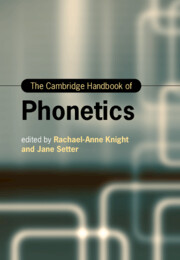Book contents
- The Cambridge Handbook of Phonetics
- Cambridge Handbooks in Language and Linguistics
- The Cambridge Handbook of Phonetics
- Copyright page
- Contents
- Figures
- Tables
- Contributors
- Introduction
- Section I Segmental Production
- Section II Prosodic Production
- Section III Measuring Speech
- 10 Measuring Vowels
- 11 Measuring Consonants
- 12 Measuring Speech Rhythm
- 13 Fundamental Frequency and Pitch
- 14 Observing and Measuring Speech Articulation
- 15 Beyond Functional Speech Synthesis
- Section IV Audition and Perception
- Section V Applications of Phonetics
- Index
- References
12 - Measuring Speech Rhythm
from Section III - Measuring Speech
Published online by Cambridge University Press: 11 November 2021
- The Cambridge Handbook of Phonetics
- Cambridge Handbooks in Language and Linguistics
- The Cambridge Handbook of Phonetics
- Copyright page
- Contents
- Figures
- Tables
- Contributors
- Introduction
- Section I Segmental Production
- Section II Prosodic Production
- Section III Measuring Speech
- 10 Measuring Vowels
- 11 Measuring Consonants
- 12 Measuring Speech Rhythm
- 13 Fundamental Frequency and Pitch
- 14 Observing and Measuring Speech Articulation
- 15 Beyond Functional Speech Synthesis
- Section IV Audition and Perception
- Section V Applications of Phonetics
- Index
- References
Summary
This paper covers the methods for measuring rhythm and the main paradigms used to study rhythm perception. An overview of ideas about speech rhythm is provided, starting with the traditional view of isochrony and rhythm classes. Production and perception methods used to establish rhythm-class differences are presented and critically reviewed, as are a number of research practices associated with them. Recent developments leading to an alternative view of rhythm are discussed, and suggestions for pedagogical practice and future research are provided.
Keywords
- Type
- Chapter
- Information
- The Cambridge Handbook of Phonetics , pp. 312 - 335Publisher: Cambridge University PressPrint publication year: 2021

